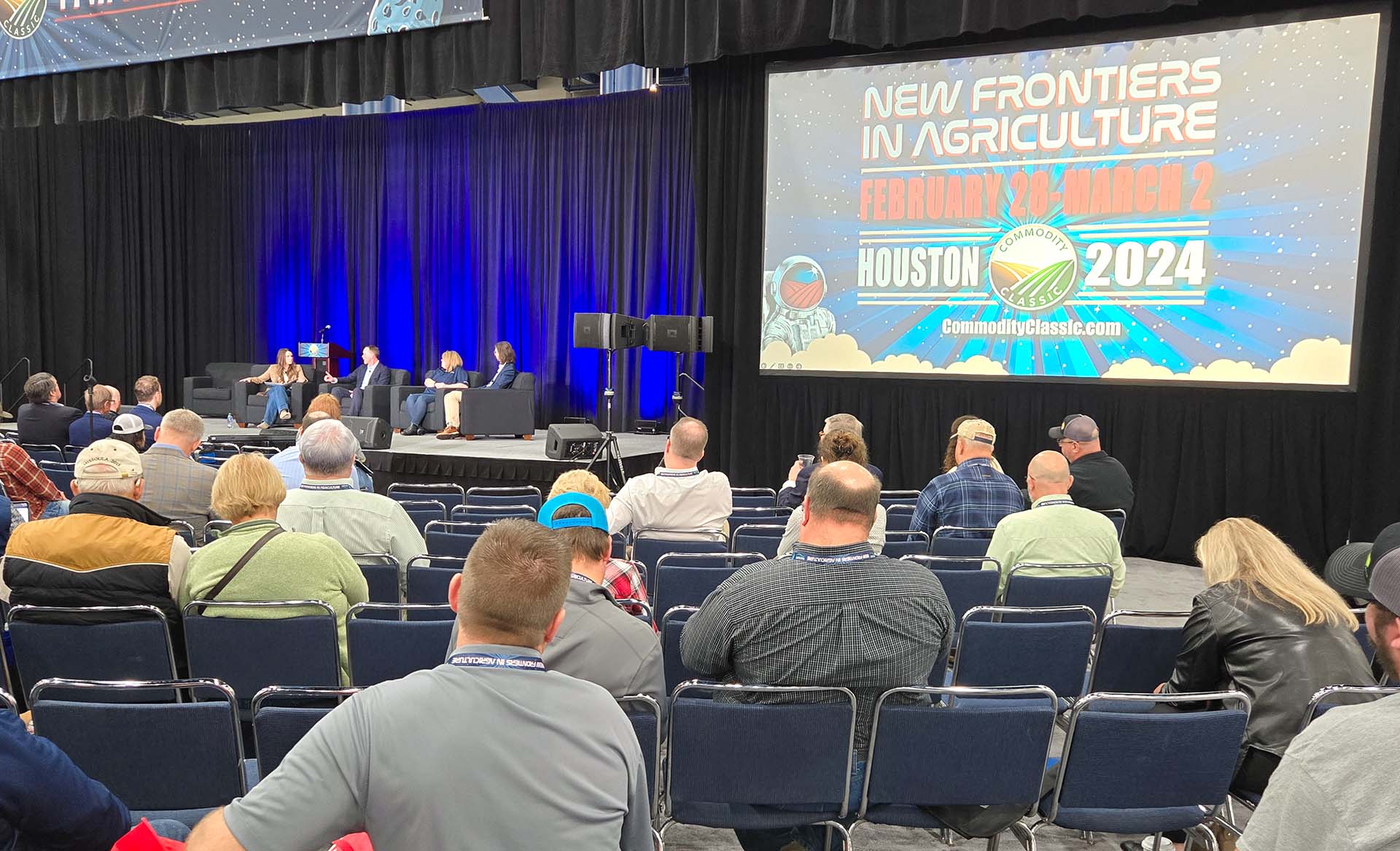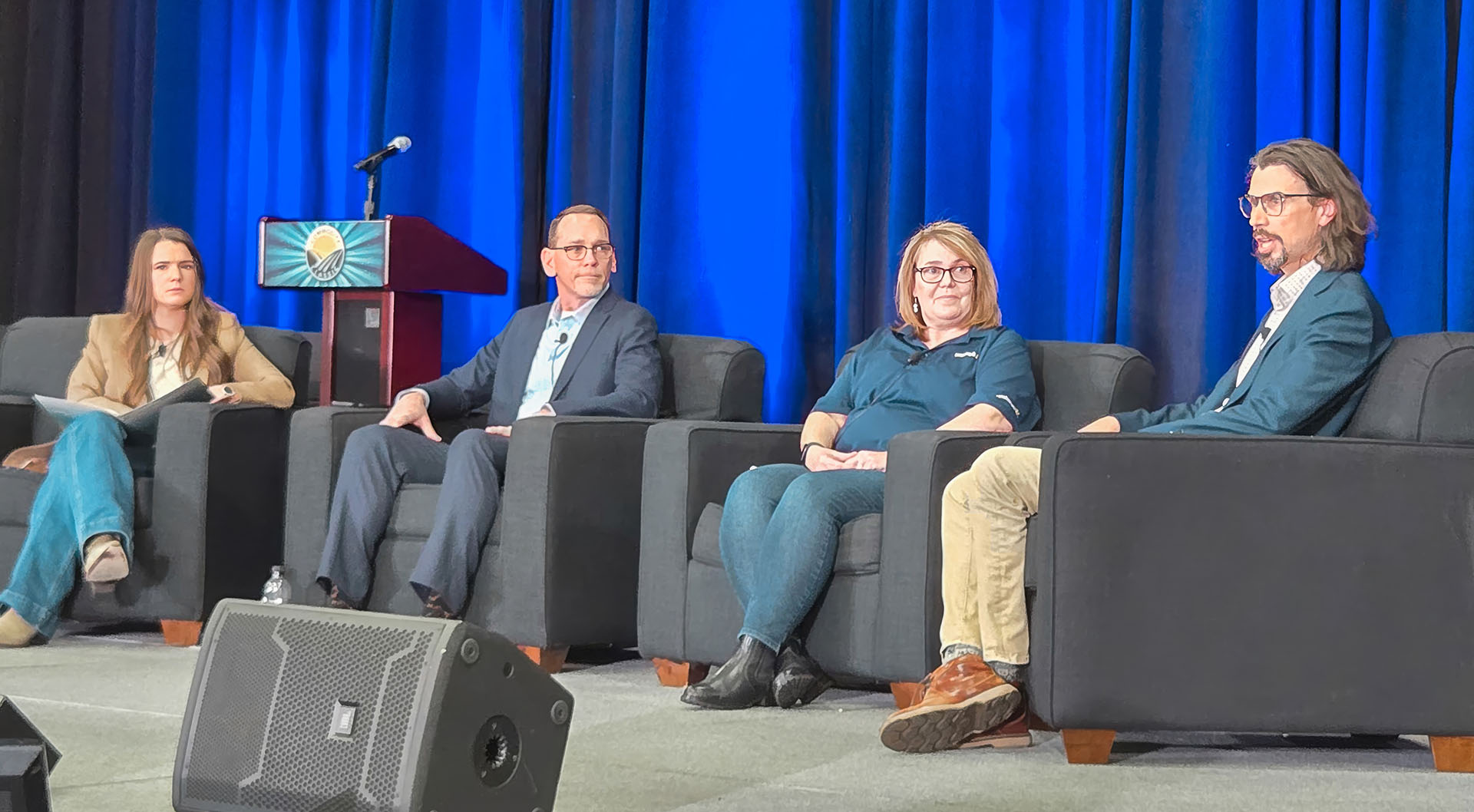
(Photo: Iowa Soybean Association / Kriss Nelson)
The first mile of success: Engaging farmers to build supply chain commitments
March 14, 2024 | Kriss Nelson
Corporations like PepsiCo and Walmart have committed to decarbonizing the agricultural end of the supply chain, which starts with the farmer.
In July, PepsiCo and Walmart announced a seven-year collaboration to pursue $120 million worth of investments focused on supporting U.S. and Canadian farmers in their pursuit of improving soil health and water quality.
The Soil and Water Outcomes Fund (SWOF) is one of the implementing partners helping to establish and scale financial, agronomic and social programs to aid farmers in transitioning to regenerative agriculture practices. SWOF is managed by AgOutcomes, a subsidiary of the Iowa Soybean Association.
The effort led by Walmart and PepsiCo aims to enable and speed up the adoption of regenerative agricultural practices on more than 2 million acres of farmland and deliver approximately 4 million metric tons of greenhouse gas emission reductions and removals by 2030.

At the 2024 Commodity Classic, David Allen, vice president of sustainability for PepsiCo, and Claire Brierly, senior manager of strategic initiatives corporate affairs for Walmart, joined Adam Kiel, SWOF executive vice president, to provide a perspective on building supply chain resilience and the value it could bring to the ag sector. The panel discussion was led by Kelsey Barnes, director of government affairs for the Farm Journal Foundation,
Barnes: Organizations appear to be making commitments to sustainability in recent years. Why does your organization care about this issue, what are your commitments, and what factors influence these goals?
Allen: Our consumers ask that crops and products be grown sustainably and manufactured and delivered by more sustainable and regenerative companies. This is important to our end consumers and our long-term investors. Those interested in PepsiCo’s economic success want to ensure that we are resilient in the face of all the challenges with climate change we are facing.
How do we continue to grow? We can’t do that without ingredients and farmers. We want to ensure we have the programs and goals that hold us accountable and enable us to make a positive impact.
From an agricultural perspective, we have established significant goals around our agricultural footprint. Our agricultural footprint is 7 million acres to support our business globally, with 3.5 million acres in the U.S. Our commitment has been to expand regenerative agricultural practices across that entire footprint.
That is in the service to soil health, biodiversity, other nature-based impacts, and carbon associated with that. We have acreage-based goals and we have emission-based goals to reduce our overall emission footprint by 40% by 2030.
I think we are at a once-in-a-generation moment regarding policy and financing that is available to enable this type of accelerated transition for the good.
Barnes: What are the goals and backstory of how Walmart is getting more involved with producers over this issue of sustainability?
Brierley: In 2017, we set ourselves an ambitious target to reduce or avoid once billion metric tons of greenhouse gases from the global value chain by 2030.
How can we use our position as the world’s largest retailer for good? How can we galvanize some of our suppliers to help come together and make it as easy as possible? We have worked for a long time with partnerships, and we will not reach our goals if we don’t engage more with agriculture and find tangible solutions to work through the challenges.
Barnes: What do you see from an AgOutcomes point of view?
Kiel: There is a connection through one end of the value chain all the way to the farmers that haven’t been there in the past. It is now being realized, and there is a willingness to work together, and that is a unique opportunity. We are in a unique position for farmers to realize the benefits of working with companies like PepsiCo and Walmart through their implementation partners.
For farmers who want to drive change and continuously improve their operations to sequester carbon in the soil, it is our job at SWOF to make it executable for the farmer and to think about what they are doing on their farm to not only share the value in the supply chain but also how it can improve that farm to become more resilient. It’s one thing to talk about cooperative goals, but there are also benefits that can be realized on the farm.
Barnes: To show you aren’t just targeting farmers regarding sustainability, could you tell us more about things you are doing outside of agriculture?
Allen: Our sustainability framework starts with ag within our first mile and takes us all the way through the last mile to how we get our products into consumer’s hands. We have organized our strategic efforts against the positive agriculture pillar and focus it on what we call a positive value chain, which is how we make, move and sell the products we make. We also have ambitious goals in those areas that encompass emissions, water use and packaging. I mentioned our ambition to reduce emissions by 40% for our entire business by 2030, but we committed to reduce that by 75% by 2030 for our internal operations. That’s transforming how our factories run and how we use alternate fuels and other methods to decarbonize transportation. We have one of the largest private fleets in North America.
Note: In 2021, an estimated 46% of Walmart’s global electricity needs were supplied by renewable sources. To reach its goals, the company is following four decarbonization pillars: scaling renewable energy, shifting to low-impact refrigerants, moving away from combustible stationary fuels and electrifying the transportation fleet.
Brierley: We are on the journey and rolling out all kinds of different initiatives that cover those four pillars. So far, 78% of waste generated has been diverted from landfills, and we are on track to reduce that to 100% in our own operations.
We have already reduced greenhouse gas emissions in scopes 1 and 2 by 23%, which has been a huge effort across the company and global supply chain.
Barnes: What are you doing to work directly with the farmers? How are these programs developed with the farmer in mind, and how are you communicating with farmers?
Allen: They are truly formed by the farmer. We have direct relationships with over 75 potato farmers and 200 corn farmers. We listen first, and that has helped us understand what’s needed and how we want to build these programs. Programs are designed to ensure we have trusted and capable implementors, and support is what farmers want and need.
It is PepsiCo’s approach is this is a voluntary process. We want folks to opt in. We believe these programs are beneficial in both the near and long term. Secondly, it is one that meets the farmer where they are. For early adopters, we designed some of our programs to recognize those who may already use these practices and incent them in a way to continue or expand. We also want to meet folks just getting started. We don’t expect a full farm conversion right out of the gate.
What we have heard as we listen to farmers is they want and need support in 3 key areas: financial support, sharing the burden of adopting these new practices; agronomic support, by these trusted implementers, like Adam and his team at SWOF to help them make the right decisions for their farms and their fields and establishing a way to create a peer-to-peer and social support.
Brierley: We are focused on an outcomes-based approach. It’s around soil health, for sure, but part of our project is farmer economic resilience. We want to make sure the program will work for the farmer and the environment.
Kiel: We built a system at SWOF to incentivize the production of environmental outcomes. The more outcomes you produce, the more value proposition there is. Farmers know markets, and I want them to think about environmental outcomes that same way. Sharing in the value and not having the financial burden be on the farmer are some of our key attributes of our program.
There are many unknowns within regenerative ag, and locking yourself into a long-term contract may not be a good thing as markets and programs develop. So, we operate year-to-year and look to get 95% re-enrolled year over year. We have seen that, which is a good indicator that we have something that works for farmers.
Farmers or landowners interested in enrollment opportunities with SWOF are encouraged to visit their website, theoutcomesfund.com
Back